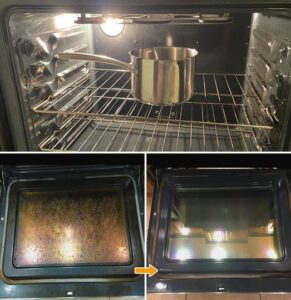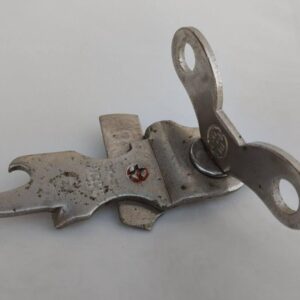Cleaning your oven might not be the most enjoyable task, but it’s a necessary one. A grimy oven not only looks unappetizing, but it can also give off unpleasant odors as leftover food turns into charred bits.
Plus, there’s the risk of your dishes absorbing that burnt taste. Moreover, when your oven is dirty, it’s hard to guarantee even cooking. And if you keep putting off the cleaning, it only gets tougher.
Experts suggest giving your oven a thorough clean every three to six months to prevent a buildup of grime. But if you’ve let it slide for longer or are dealing with a particularly stubborn mess, don’t fret. There are effective methods to get your oven, including the racks, doors, and knobs, looking brand new.

Here are five foolproof methods to clean your oven:
Method 1:
The self-clean option This is perhaps the simplest way to clean your oven, and it doesn’t require any harsh chemicals or back-breaking scrubbing. According to Paul Bristow, the executive director of built-in cooking at GE Appliances, the self-clean cycle is a handy feature that saves time. “During the cleaning cycle, the oven is heated to about 880 degrees Fahrenheit. At this temperature, food inside the oven incinerates, leaving behind a small amount of ash. The leftover ash wipes out easily with a damp cloth.” Just be sure to let the oven cool down before you start wiping the interior.
However, there are some downsides to using the self-clean cycle. It locks up the oven for three to five hours, and it can also raise the temperature in your kitchen, which might be uncomfortable in the summer. Additionally, it can produce an unpleasant smell, so it’s a good idea to clear out while the cycle is running. The biggest drawback, though, is that it may not completely remove tough stains and grease. Stubborn spots might require another cycle or some good old-fashioned elbow grease.
Method 2: Store-bought oven cleaner
For this method, you can easily grab a commercial oven cleaner from the store. Start by removing any big pieces of food or loose ash. Then, spray the cleaner inside the oven. Let it sit for about 30 minutes before wiping it away. Since these cleaners can be quite strong, it’s a good idea to open windows and put on gloves and a face mask while you’re cleaning.
Method 3: Baking soda and vinegar
If you prefer not to use harsh chemicals, or if you simply don’t want to go out and buy them, you can create your own cleaning solution using vinegar, baking soda, and water. According to Jessica Samson, director of national branding for The Maids, “The baking soda acts like a gentle scrub while the water helps soften and loosen up any stubborn food particles.” Make a paste and spread it generously over the interior surfaces of the oven. Let it sit for at least 20 minutes (ideally longer) to break down any burnt-on food.
For an extra cleaning boost, spray some vinegar over the baking soda paste and leave it for another 20 minutes. Then, scrub the oven using non-abrasive pads and finish by wiping it down with a damp microfiber cloth.
Method 4: Baking soda and lemons
This method involves using either two large lemons or half a cup of citric acid. Begin by sprinkling baking soda all around the inside of the oven, then scrub it with water to ensure it’s evenly spread. Allow it to sit for about 10 minutes. Next, mix the juice from the two lemons or the citric acid with a bucket of warm water. Use this mixture to wash away the baking soda. Once the oven is clean, give it a final rinse with the lemon water to leave a pleasant citrusy scent.
Method 5: Steaming
Steaming offers a DIY alternative to running a self-clean cycle, and it’s just as straightforward. “Place a pan of water in the oven and set it to 225 degrees Fahrenheit for at least 15 minutes,” advises Kris Koenig, CEO of Natura Clean. Once it’s cooled down a bit, add some dishwashing soap to the pan of water. Then, use this soapy water along with a nylon sponge or a non-scratch wool pad to scrub away the loosened-up grime, as well as the entire interior of the oven.
BONUS TIPS FOR OVEN CLEANING:
Before you start cleaning, always ensure that the oven is completely turned off and has cooled down.
When using strong cleaning agents, it’s a good idea to wear protective rubber gloves and clothes, especially for harsh chemicals.
Remove any large pieces of dirt or food residue by hand before applying the cleaner.
For hard-to-reach spots, like corners and crevices, a toothbrush can be quite handy.
For stubborn grease build-up, try applying a mixture of baking soda and a spritz of vinegar. Leave it overnight and wipe it away with a sponge.
If you’re cleaning a gas oven, be cautious not to let the cleaner drip into the gas burner under the vent slots. You can cover the bottom vent with foil while cleaning to prevent this. Just remember to remove the foil before using the oven again.
HOW TO CLEAN OVEN RACKS:
Regardless of the cleaning method you choose for your oven, tackle the metal racks separately. Take them out and soak them in a solution of boiling water and dishwasher soap. You can use a large basin, sink, or even the bathtub. After about two hours, give the racks a good scrub with a stiff brush or steel wool. Once they’re rinsed and dried, put them back in your freshly cleaned oven. Just a reminder, only use steel wool on the racks, not on the oven’s interior, as it could damage the steel or porcelain finish.
HOW TO CLEAN OVEN KNOBS:
Use a damp microfiber cloth to gently wipe down the knobs. If needed, add a bit of soap. Avoid spraying them directly; instead, spray the cloth. “The liquid could seep behind the knobs and switches, potentially causing a short in the control panel,” warns Ron Shimek, president of Mr. Appliance. “Instead, apply cleaner to a rag and then clean the controls to prevent any shorts.”
HOW TO CLEAN GLASS OVEN DOORS:
Create a paste using ½ cup of baking soda and 3 tablespoons of dishwashing soap. Spread it on the inner glass of the oven door and let it sit for at least thirty minutes. Once the grime is easy to wipe away, use a non-abrasive sponge to clean off the paste. For the outer glass, use either white vinegar or glass cleaner and scrub with a non-abrasive sponge. Rinse with a wet cloth. Be careful not to use harsh scrubbers or scouring pads that might scratch the glass surface.



